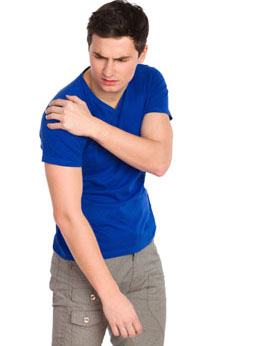Torn cartilage in shoulder can be a very painful condition, which needs immediate medical attention. Read on for more information about how does torn shoulder cartilage occur and also about the shoulder arthroscopy procedure.

The shoulder has a ball and socket joint which is similar to the hip joint. However, as compared to the hip joint, the shoulder joint is shallow and unstable. To prevent the dislocation of the bones in the shoulder joint, there is a layer of rotator cuff muscles (or the shoulder muscles), called labrum to provide extra support to the shoulder. This cartilage makes the shoulder joint stable by creating more space in the glenoid or the shallow shoulder joint. It supports a variety of movements like swinging of the arm and rotation. A wrong movement of the shoulder joint can lead to a torn cartilage in the shoulder.
Types of Torn Cartilage
The shoulder muscles or labrum is very susceptible to injuries and trauma. Sometimes due to stress and overexertion of the tissue, the cartilage tends to tear leading to torn ligament in shoulder. This torn cartilage in the shoulder joint results in pain and discomfort, which may range from mild to severe, depending on the type and the extent of the injury. The labral also loses its elasticity with age which can also lead to shoulder injury. A tear in the cartilage can also occur due to trauma and natural degeneration, which happens due to strain on the muscle or even due to age.
There are three common types of torn shoulder cartilage: (1) Bankart lesions; (2) Posterior labral tears; (3) SLAP tears.
(1) Bankart lesions occur when the shoulder joint comes out of the socket, resulting in dislocation of the shoulder. Since the labral is torn, the shoulder becomes more prone to injuries and dislocations.
(2) Posterior labral tears are mostly seen in athletes who tend to suffer from a condition known as internal impingement, where the labrum and the shoulder muscles are pinched together, which can be painful. This condition often occurs due to a strain in the shoulder joint and restricts free movement.
(3) SLAP tears are common in tennis players and baseball players.
SLAP stands for
Superior
Labrum from
Anterior to
Posterior. This tear occurs in the place where the biceps tendon is attached to the shoulder at the top of the joint. Lifting a heavy object, falling onto an outstretched hand and repetitive overhead actions, like throwing an object can cause a SLAP tear.
Symptoms
The signs of a tear in the cartilage tissue depend on the location of the injury. Some of the indications are given below:
- Experiencing severe pain at the joint
- Pain is triggered even at slight movements
- Catching sensation while moving the shoulder or doing certain activities
- Swelling in the affected region and localized discomfort
Treatment
It is very essential to treat shoulder dislocation immediately instead of waiting for it to heal on its own. Delayed treatment can result in damage to the nerves, blood vessels, muscles and tendons, which may increase the suffering and healing time. If the doctor suspects a torn ligament in shoulder, he may assess the history of the injury and causative factors of shoulder pain. He may also ask the patient to undergo a series of tests, like a shoulder X-ray to determine the exact location of the injury.
➀ The doctor may prescribe
anti-inflammatory drugs and painkillers to reduce the swelling and lessen the pain.
➁ The shoulder then will be put in a
sling or an immobilizer to restrict the movement of the shoulder till it heals completely.
➂ There are some
exercises, which can be followed, but under the supervision of an expert or a physical therapist.
➃
Shoulder arthroscopy, is a process where the seriousness of the injury is examined with the help of a tiny camera known as arthroscope. This procedure involves a minimal invasive surgery where the camera is inserted into the skin around the injury through a small incision. This surgery is carried out under general or local anesthesia.
Shoulder dislocation can be very discomforting and painful and so it is necessary to take precautionary measures while exercising or doing heavy work to prevent a tear in the shoulder cartilage.
Disclaimer: The article published herein, is meant for educational purposes only and does not intend to supplant the advice of a physiotherapist.


 The shoulder has a ball and socket joint which is similar to the hip joint. However, as compared to the hip joint, the shoulder joint is shallow and unstable. To prevent the dislocation of the bones in the shoulder joint, there is a layer of rotator cuff muscles (or the shoulder muscles), called labrum to provide extra support to the shoulder. This cartilage makes the shoulder joint stable by creating more space in the glenoid or the shallow shoulder joint. It supports a variety of movements like swinging of the arm and rotation. A wrong movement of the shoulder joint can lead to a torn cartilage in the shoulder.
The shoulder has a ball and socket joint which is similar to the hip joint. However, as compared to the hip joint, the shoulder joint is shallow and unstable. To prevent the dislocation of the bones in the shoulder joint, there is a layer of rotator cuff muscles (or the shoulder muscles), called labrum to provide extra support to the shoulder. This cartilage makes the shoulder joint stable by creating more space in the glenoid or the shallow shoulder joint. It supports a variety of movements like swinging of the arm and rotation. A wrong movement of the shoulder joint can lead to a torn cartilage in the shoulder.